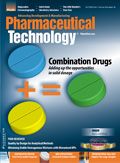Partnerships Remain Crucial to Future Development
Working together affords many unseen opportunities for pharmaceutical innovation.
With the nature of our industry shifting vastly, partnerships have become essential to continued success and productivity in the field. It is important that scientists and researchers establish these relationships within big and small pharma, academia, government, and professional organizations, such as the American Association of Pharmaceutical Scientists (AAPS), to help keep the industry moving forward. But, as with any relationship, there are bound to be challenges.

David Mitchell, PhD
Managing partnerships with CROs, for example, is a necessity for many in the pharmaceutical sector. Pharma companies have a broad strategic rationale for clinical outsourcing and are still experimenting with different CRO relationship models. According to an April 2012 report from Booz & Company, "Nimble Partnerships in the Pharma Industry," there are four types of relationship models emerging: Qualified Talent Supplier, Preferred Capacity Partner, Preferred Capability Partner, and Strategic Partner. To develop sustainable value from these relationships, companies must align the design, structure, and performance measures of their relationships with their strategy. Companies that adopt a quick, capability-centered approach to partnerships are likely to be more focused, make better use of their distinct capabilities, and generate more value.
Much of consulting is about one's network. Partnerships with other consultants can broaden a consultant's network, provide more opportunities, and allow one to assemble a "complete package" for a given project. For example, if approached by a client to complete a clinical trial, I might design the trial, write the protocol, analyze the data, and write the report. But I need a partner to run and monitor the trial, complete the bioanalytical assays, possibly prepare regulatory documents, and provide a medical opinion on the safety aspects of the trial. By partnering with the right group of consultants, I can put together a "virtual project team" to complete the study with expertise in every required area.
In recent years, industry has also taken a more collaborative approach with academic research institutions. Academia holds a strong role in the advancement of drug discovery and has created great partnering relationships with companies. Tightening federal budgets have put a strain on academic laboratories, and the industry is trying to cut costs and improve productivity by outsourcing. This environment allows for the increased opportunity for collaboration from both parties and an increased acceleration in drug discovery.
AAPS recognizes the importance of partnerships in our field. During the past few years, the association has partnered and cosponsored events with numerous organizations, including FIP, FDA, ACCP, ASCPT, and GBC.
In addition, the association continues to partner with its members to bring them the information, both scientific and for professional development, they need. One area of focus during my presidency has been on the changing nature of our membership. Last year, AAPS created a Big Pharma/Small Pharma Task Force to identify the unique needs of the members from smaller pharmaceutical and biotechnology companies, CROs, and consultants, and to determine how AAPS could adapt to meet their changing needs.
The task force presented recommendations to ensure that members who are part of small pharma and biotech companies do not feel overshadowed by those employed in Big Pharma. These recommendations are particularly important to AAPS; nearly 50% of our members now reside at a small pharma/biotech company, CRO, or as a consultant. One recommendation was to allocate programming at this year's annual meeting (taking place Oct. 14–18 in Chicago) geared specifically towards members working at small companies, which has been completed. Additionally, we have learned that there is a need for more programming on discovery, a primary activity of small pharma, biotech, and academia. Lastly, we're organizing a summit of key pharmaceutical leaders to discuss the progression of the industry over the next 20 years. Our goal is to identify what industry, government, and academia need to be successful and how AAPS can help.
AAPS continues to take steps to adapt to shifting trends through partnerships with other organizations and our members. Part of adapting to our changing industry is continuing to provide the tools that members need to access the latest information and stay connected. Forming these partnerships is of utmost importance to us.
David Mitchell, PhD, is president of the American Association of Pharmaceutical Scientists (AAPS).

Pharmaceutical Tariffs Are Imminent: How Industry is Bracing for Impact
April 16th 2025On April 14, 2025, the Trump Administration launched a national security-driven investigation into pharmaceuticals, a move that will likely result in tariffs being placed on pharmaceutical drugs, ingredients, and other components that are imported from outside of the United States.